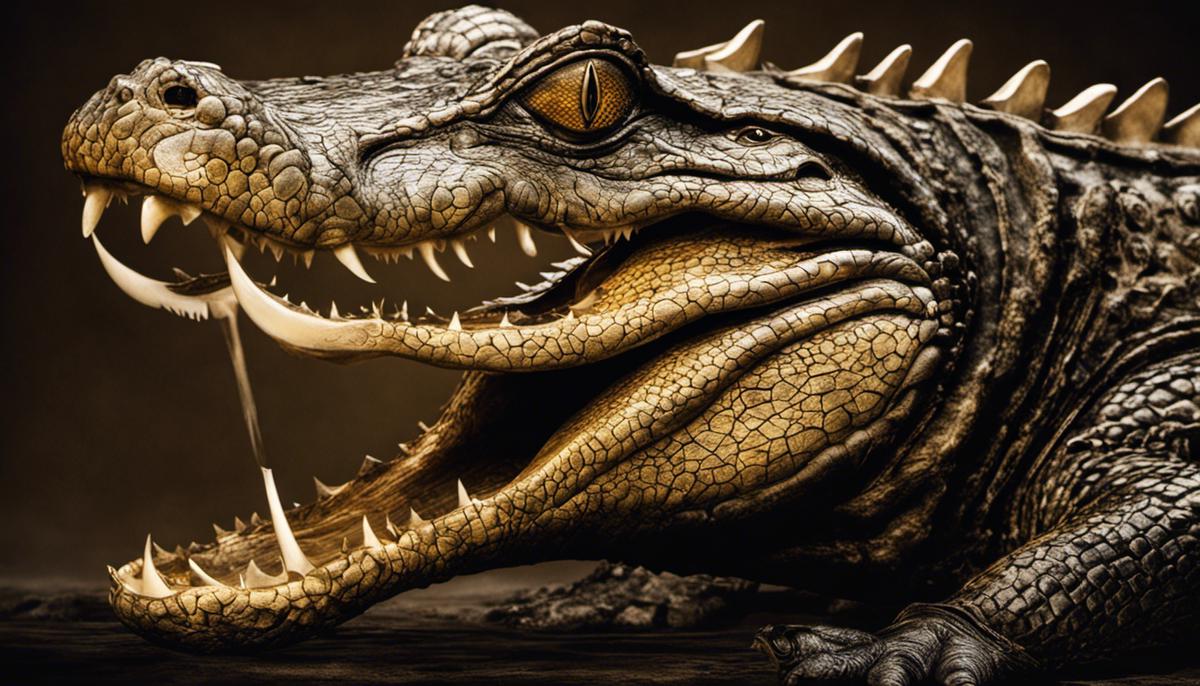Interpreting the symbolic meaning of dreams has been an intricate part of human history, with profound cultural, psychological, and religious significance attached to them. Dream interpretation has found its prominence within the sphere of Christianity, leaving a trail of mysteries, revelations, and prompts for deeper spiritual introspection. In this discourse, the spotlight is on alligator dreams, an uncommon yet incredibly potent symbol within the Christian context. The alligator, a creature of the wild, ancient, and often feared, serves as a compelling character in the narrative of dream symbolism. Investigating its historical context, symbolism within Christianity, biblical perspective, psychological and spiritual implications, and providing practical examples, we delve into decoding this powerful dream symbol and its implications for the dreamer.
Historical Context of Dream Interpretation
The Evolution of Dreams and Symbolic Interpretations Within Christianity: A Focus on Alligators
The purview of Christianity extends far beyond mere religious dogma and rituals. One fascinating domain is the interpretation of dreams and symbols, a field of study that has experienced considerable shifts over time. Embedded within this complex maze of interpretations, the alligator stands as a symbol that intriguingly showcases Christianity’s evolving perspectives on dreams and symbols.
The seership of dreams traces back to the Bible, where dreams represented divine communication or prophetic visions. Joseph, an Old Testament figure, was known for his ability to interpret dreams, such as the Pharaoh’s dream, which he decrypted as a warning about seven years of famine. Similarly, there are numerous instances in the New Testament where dreams were understood as a Spirit-driven manifestation, often embodying moral and spiritual guidance.
The study of Christian symbolism is naturally linked to its Biblical roots, with each symbol deeply intertwined with Scripture. Yet, interpretation is not foolproof and has witnessed various transformations. The alligator, for instance, falls into this elusive category and has been viewed differently at different historical junctures.
In early Christian symbolism, the alligator represented sin and evil, reflecting the fear and detestation for the wild and the unknown prevalent during this time. Quintessential Biblical imagery, such as the Leviathan in the Book of Job, enhanced this antagonistic interpretation of the alligator. The Leviathan was an aquatic creature, which scholars often analogize to the alligator or crocodile, embodying chaos, evil, and deceit.
Contrary to the above, in the Middle Ages, alligators were seen as protectors seeking divine intervention. The “Psalter of St Augustine” portrays an image of an alligator opening its mouth while a bird cleans its teeth, a scene symbolizing preservation and cleaning the soul from sins through confessionals.
In recent times, the consolidation of psychological theories into dream interpretation by pioneers like Carl Jung and Sigmund Freud has been influential. The alligator often symbolizes subconscious fears and repressed feelings in contemporary interpretations, reflecting a radical shift from the religious lens of earlier times.
Brought into the modern era, the alligator’s symbolism has been absorbed into popular culture, carrying both positive and negative connotations. It can symbolize hidden strength and intrinsic survival instincts, denoting faith and resilience. Nonetheless, it might also be seen as a symbol of lurking danger and duplicity, echoing its ancient Biblical interpretation.
As with several symbols and dreams within Christianity, the alligator’s interpretation has been dynamic. This seemingly strange creature’s evolving interpretation underscores Christianity’s astounding adaptability as a religion, ready to alter its interpretation of symbols in alignment with the changing societal viewpoints. At the crossroads of religion and society, one can glean insights about human philosophy, metaphysics, and socio-cultural history, probing deeper layers of our collective thinking.
In conclusion, the alligator example illustrates the changing face of dreams and symbolic interpretation within Christianity. It accentuates Christianity’s ever-evolving nature, reminding us that religions are not fossilized but rather dynamic and responsive, adapting and keeping pace with shifts in societal cognition and comprehension.

Symbolic Meaning of Alligators in Christianity
Delving deeper into the pantheon of Christian symbolism, the alligator, for centuries, has been an apt representation of hidden realities within our spiritual selves. Inextricable from the primordial chaos represented by the Leviathan is the significance of the alligator as sin, evil, and deceit personified. To properly genuflect towards this topic, engaging with the contextual narrative is mandatory.
One fascinating aspect to grasp of the alligator within the Christian narrative is the dichotomous symbolism it embodies, blurring the lines between secular and religious interpretations. For instance, it is widely acknowledged that alligators are ancient creatures, surviving unchanged over millions of years. Scientific insight into their evolutionary success has influenced religious metaphors, associating alligators with durability and tenacity, leaving indelible markers on the sociocultural landscape of symbolism.
Interestingly, alligators, in the Christian tradition, have sometimes been depicted as symbols of resurrection. With an uncanny resemblance to logs when they float motionless in the water, their sudden, lively motion often represents unexpected rebirth and the promise of new beginnings emerging from stagnant circumstances.
Catholic saints, most notably Saint Ambrose, have used the alligator as an instructional tool. The mother alligator’s mythologized practice of placing her young within her mouth for protection, even at the risk of self-harm, epitomizes self-sacrifice and unconditional love, reflecting Christ’s ultimate sacrifice.
Moreover, considering the Book of Job, the alligator, akin to the crocodile or Leviathan, bears an oppressive array of teeth, symbolizing the grasping and relentless nature of sin. This enforces its identity as a destructive force, adding to its multifaceted role in religious lore.
The dynamic and flexible symbolism of the alligator also hints at the adaptability of Christian thought systems. With distinctive cognitive dispositions, humans have used this symbolic animal as a conduit for both fear and reverence, simultaneously embodying danger and protection, chaos and preservation. The alligator, in many isolated religious communities, has been considered a holy animal – a guardian, entailing an intriguing dichotomy of perceptions.
To conclude our understanding of the alligator in Christian symbolism without conclusively ending the complex labyrinth of interpretations, it is paramount to combine scientific thought, psychological implications, and socio-cultural contexts. The result is an enriched matrix of understanding that takes into account the human need for metaphorical representation and procedure of semiotics within religion. The power of an emblem like the alligator showcases the human capacity to invest meaning in natural elements to understand inexplicable spiritual realms, and enriches our understanding of Christianity’s metaphysical dimension. Venues of symbolism offer prime specimens to delve into the cognitive machinery of humans, especially when approaching such potent symbols as the alligator within Christian religious tradition. Approaching these symbols within the confines of their unique cultural and religious contexts brings us closer to understanding our collective human heritage.

Alligator Dreams in Biblical Perspective
Further delving into the nuances of religious dream interpretation, it becomes apparent that alligators within this context are often considered visual manifestations of hidden spiritual aspects. This symbolic interpretation suggests that these imposing creatures encompass the mysteries surrounding our spiritual identities and unveil unrealized truths that are veiled in our everyday consciousness. This premise aligns the metaphorical alligator with the broader Christian narrative of unmasking and confronting the ethereal realms of our being.
It is also reasonable to postulate that the alligator, within a Biblical dream context, embodies the personification of sin, evil, and deceit. As its biblical associate, the Leviathan, is associated with chaos and deceit, so too might the alligator represent spiritual transgressions and dishonesty.
Intriguingly, the symbolism of the alligator remains somewhat dichotomous, converging secular and religious interpretations. Despite being a figure commonly associated with foreboding and fear, it also embodies durability, tenacity, and evolutionary success. Thereby, the alligator becomes a paradoxical symbol that both frightens and uplifts.
More strikingly, alligators have been embraced as symbols of resurrection and new beginnings. Drawing connections between its earthly survival tactics and the theological premise of rebirth, the alligator’s ability to thrive in diverse environments is likened to the Christian’s spiritual journey towards salvation.
Historically, the figure of the alligator as an instructional tool employed by Catholic saints can be detected. For instance, Saint Augustine, an influential theologian, considered the alligator a metaphor assisting believers in understanding the concept of sin’s omnipresent nature. He perceived the creature’s oppressive teeth as illustrating the relentless nature of sin that constantly seeks to devour the faithful.
The symbolism of the alligator demonstrates the adaptability of Christian thought systems. Within different cultural and historical contexts, its interpretation has oscillated between embodying profane, demonic elements and personifying profound, divine attributes. Reflective of Christianity’s resilience, the alligator’s symbolism portrays an ideological flexibility catering to divergent cultural narratives.
So diverse are the insights provided by this exploration that in some religious communities, the alligator has been revered as a holy creature and guardian. These perspectives challenge mainstream representations and illuminate the creature’s complex role that resonates in various societies worldwide.
By synthesizing scientific thought, psychological implications, and socio-cultural contexts, a comprehensive understanding of the alligator’s multifaceted role in Christian symbolism can be made. This triangular approach allows for an enriched, nuanced grasp of the influences contributing to the symbolic narrative of this creature.
Ultimately, symbols like the alligator potentiate humanity’s understanding of the metaphysical dimension within Christianity. Their potency lies in their accessibility, pervading the realms of the divine and secular. As such, they continue to shape Christian theology, practice, and discourse, provoking introspective reflections and offering tantalizing glimpses into the profound mysteries that religion continuously seeks to unravel.

Psychological and Spiritual Implications
Moving deeper into the labyrinth of the ecclesiastical semiotics, there is a rich tapestry of symbolism to unravel surrounding the figure of the alligator. To interpret dreams with an alligator in them, it is indispensable to consider multiple perspectives, drawing from theoretical discourses in ontological psychology, metaphysical philosophy, hermeneutics, and theology, and situate these within the sociocultural-historical fabric of Christianity.
Emulating the work of renowned dream interpreters like Carl Jung and Sigmund Freud, who hypothesized the subconscious as a reservoir of repressed thoughts and emotions, one can postulate that gators in dreams may manifest suppressed spiritual disquiet or moral uncertainty. The dreamer could be grappling with dilemmas of faith, wrestling with tensions between orthodoxy and heterodoxy, or questioning scriptural interpretations.
Expanding on the negative connotations of alligator symbolism, stemming from the biblical Leviathan, it is intriguing to juxtapose these against their seemingly contradictory use by some Catholic Saints, such as Saint Augustine. Would the alligator, a feared and enigmatic creature, not make a powerful pedagogical tool to illustrate intricate theological narratives? Additionally, alligators offer rich metaphorical lessons of resilience, tenacity, and adaptation – virtues, one could argue, indispensable in navigating the spiritual journey.
Simultaneously, the representation of the alligator as resurrection, rebirth, or renewal implies the cyclical nature of existence and the possibility of spiritual metamorphosis. Borrowing from gnostic thought and early Christian esoteric traditions, the alligator can personify inner transformation and the emergence of a new spiritual identity.
As a holy animal and protective guardian in some religious sects, the alligator sanctions the idea of spiritual plurality and relativity of religious symbols. Just as the interpretation of dreams is contextual and individual-driven, so too is the symbolism of the alligator, undulating between reverence and revulsion across different religious landscapes and temporalities.
By alchemizing insights from behavioral science, functional interpretations from psychological theories, and the cultural significance of Christian metaphysics, it is possible to distill a more interwoven, nuanced understanding of the alligator’s role in religious symbolism, dreams, and intellectual discourses.
Undoubtedly, symbols like the alligator profoundly influence the landscape of Christianity, shaping theological debates, informing praxis, and enriching the discursive milieu. By interpreting such symbols, one can better understand the nuanced dimensions of spirituality and the psychological dynamics underpinning religious experience. From an academic standpoint, symbols like the alligator flood the avenues for more interdisciplinary research and interfaith dialogues.

Practical Examples and Application
Interpretations steeped in the symbolic analysis of dreams in religious texts, especially in Christianity, transcend mere theoretical ruminations.
These interpretations, as vividly represented by the symbology of the alligator in biblical narratives to modern-day dream analysis, bear immense practical relevance within a myriad of contexts – personal awakenings, self-discovery, societal norms, adaptation to change, and even in fostering an understanding of shared human chronicles.
Delving first into the private sphere, interpretations derived through biblical dreams and symbols—like the alligator—can serve as reflective mirrors for hidden spiritual aspects.
Such religious symbols, permeated with dualities of evil and salvation, fear and reassurance, sin and redemption, can provide individuals with signposts towards their own spiritual growth.
The emergence of the alligator in one’s consciousness or dreams could spur an internal dialogue and a quest for self-improvement or change.
In terms of societal implications, symbols not only constitute the basis for cultural norms and beliefs but also offer tools for constructive dialogue.
For instance, the use of the alligator—once symbolizing sin and deceit, now also emblematic of durability, new beginnings, and even holiness—in pedagogical environments helps navigate complex spiritual discourses.
Teachers, religious figures, or even parents can draw upon the history and multilayered symbolisms of the alligator to impart essential life lessons about adaptability, resilience, and the dichotomous nature of life.
Furthermore, the evolutionary trajectory of the alligator’s symbolism underlines the adaptability of Christian thought systems, addressing both practical concerns and evolving societal conditions.
With historical precedents like Saint Augustine using symbols such as the alligator as instructional tools, to the current-day sanctioning of the misunderstood creature as a guardian in some communities, these shifts underscore the capacity for ideological flexibility within Christianity.
This adaptability can pave the way for more inclusive societal structures, reflecting the pluralistic nature of religious beliefs and practice.
Additionally, the alligator’s symbolism, anchored in the complexity of associated connotations, signifies how theological debates can be informed from cross-disciplinary perspectives.
The alligator’s role as a symbol of subconscious fears, repressed feelings, resilience, and new beginnings offers an opportunity to integrate insights from psychology, sociology, and even evolutionary biology into theological discussions.
Such interdisciplinary approach can lead to a more nuanced understanding of religious practices and contribute to fostering interfaith dialogues.
Lastly, in understanding the metaphysical aspects within religious beliefs and practices, symbols like the alligator wield substantial power.
As individuals and societies navigate shifting paradigms, such symbols serve as constellations guiding them through the tumultuous, yet fascinating expedition into spiritual discovery.
The ever-evolving symbolism of the alligator, interweaving threads of ancient biblical narratives, psychological implications, and socio-cultural contexts, thus becomes a portal for exploring the rich tapestry of Christianity.
In essence, the exploration of symbols like the alligator within Christianity affirms that interpretations derived from such analysis extend far beyond theoretical constructs.
These interpretations, anchored in the foundational saga of dreams and the cosmic dance of symbols, are instrumental in delineating the evolving contours of personal introspection, societal norms, theological debates, and indeed, the shared fabric of human existence.

Through the exploration of history, theology, psychology, and personal experiences, we have embarked on a journey to reveal the multifaceted interpretations of alligators within Christian dream symbolism. While it necessitates personal introspection and divine guidance for an accurate understanding, the symbolism of alligators in dreams serves as foundational pieces of a larger puzzle of the dreamer’s spiritual journey. Thus, symbol interpretation, particularly of alligator dreams, paves way for an enriching dialogue between the dreamer’s internal psyche and their spiritual inclinations. Such a divine interaction cultivates deeper spiritual growth, resilience, and offers an empowering perspective on how to navigate life’s complexities, with profound faith and wisdom.








